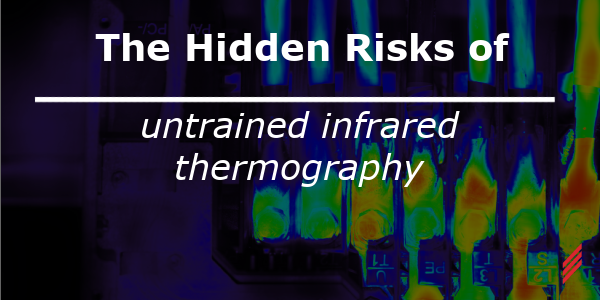The Hidden Risks of Untrained Infrared Thermography
by Bryan Campbell, PE on Oct 23, 2025 10:30:00 AM

Infrared thermography (IR), also known as thermal imaging, is a powerful diagnostic tool used across industries to identify issues in electrical systems, mechanical equipment, and building envelopes before they become serious problems. By detecting infrared energy (heat) and converting it into an image, thermography allows for non-invasive and non-contact monitoring of equipment and infrastructure health.
While the technology is becoming more accessible and user-friendly, one significant issue remains: the misuse of infrared thermography by untrained personnel. At first glance, pointing a thermal camera at equipment and reading a heat map may seem straightforward. However, without the proper training and understanding, staff can easily misinterpret results, overlook critical problems, or create false alarms that waste time and resources.
In this blog, we’ll explore the key disadvantages of conducting infrared thermography without proper training and certification—and why professional handling of this powerful technology is essential to safety, efficiency, and cost-effectiveness.
Misinterpretation of Thermal Images
One of the most common issues with untrained use of infrared thermography is incorrect interpretation of thermal images. IR cameras detect surface temperatures, but these readings are not always direct indicators of underlying issues unless interpreted in the proper context.
For example, an untrained user might mistake a “hot” area on an electrical panel as a critical fault, when it may simply be a normal heat signature caused by load imbalance. Conversely, a truly dangerous hotspot could be dismissed as harmless due to poor analysis.
Real-World Consequence:
- False positives can lead to unnecessary shutdowns, inspections, or part replacements.
- False negatives can allow actual faults to go unnoticed, leading to equipment failure or safety hazards.
Lack of Understanding of Emissivity and Reflectivity
Thermal cameras rely on the emissivity of a surface—the ability of a material to emit thermal radiation. Different materials (metal, plastic, painted surfaces) have varying emissivity values, and if these are not properly set on the thermal camera, the readings will be inaccurate.
Untrained personnel often don’t account for:
- Reflective surfaces that can show misleading heat from nearby sources (like sunlight or other machines).
- Variations in emissivity across different components in the same image.
- Environmental factors like wind or moisture that affect surface temperature readings.
Incorrectly adjusting (or not adjusting) the camera for emissivity can render the data collected essentially useless.
Failure to Follow Industry Standards
There are recognized standards for conducting infrared thermographic inspections, such as ISO 18434, NFPA 70B, and ASTM E1934. These guidelines outline:
- Proper inspection procedures
- Environmental conditions for scanning
- Required documentation
- Equipment calibration
- Safety protocols
Untrained staff are often unaware of these standards and may inadvertently:
- Conduct scans in poor conditions (e.g., direct sunlight or rain)
- Use uncalibrated equipment
- Fail to document findings in a usable or traceable way
This results in reports and data that cannot be used reliably for maintenance planning, audits, or insurance claims.
Overlooking Safety Protocols
Infrared inspections are often performed on live electrical equipment to identify thermal anomalies under normal load. This means the person using the IR camera may be exposed to electrical hazards, arc flashes, or hot surfaces.
Without appropriate training, staff may:
- Use incorrect personal protective equipment (PPE)
- Open panels without proper lockout/tagout procedures
- Stand too close to energized equipment
This puts both the untrained user and nearby staff at risk of injury—or worse.
Incomplete or Poor-Quality Reports
One of the major values of thermography is not just the image, but the reporting—documenting findings, assigning severity levels, and making actionable recommendations. Trained thermographers know how to:
- Compare results to baseline readings
- Analyze load conditions
- Include multiple imaging angles
- Create clear, professional reports with detailed annotations
Untrained personnel might generate reports that are unclear, incomplete, or lack the necessary information for decision-makers to act. In turn, this undermines the credibility and utility of the thermography program.
Wasted Investment in Technology
Thermal imaging cameras are not cheap. Many companies invest thousands of dollars into equipment hoping to reduce maintenance costs, improve uptime, and ensure safety.
But when these tools are used by individuals without proper training, that investment is often wasted:
- Misused cameras may require costly recalibration or replacement.
- Poor data quality results in no actionable insights, rendering the inspection process ineffective.
- Inconsistent usage across teams leads to confusion and poor data tracking.
Training is essential to maximize the ROI of thermographic equipment.
Legal and Compliance Risks
In regulated industries (e.g., utilities, manufacturing, construction), there may be legal or insurance requirements for condition monitoring. Inspections conducted by uncertified or unqualified individuals may be non-compliant, especially if used for:
- Fire risk assessment
- Insurance documentation
- Equipment warranty verification
- Compliance audits
If an incident occurs and it's found that untrained personnel performed or misinterpreted thermography, your company could face liability issues or non-compliance penalties.
Undermining the Value of Predictive Maintenance
Thermography is a cornerstone of predictive maintenance—a proactive approach to identifying problems before they result in failure. But when thermal data is inconsistent, unreliable, or misinterpreted, the entire strategy breaks down.
- Maintenance teams may stop trusting the data.
- Leadership may scale back predictive initiatives due to perceived ineffectiveness.
- Equipment failures may rise due to missed early-warning signs.
In short, improper use of infrared thermography can erode confidence in an otherwise powerful maintenance tool.
Conclusion: Invest in Training for Real Results
Infrared thermography is a valuable technology—but only when used by properly trained and qualified personnel. Without this foundation, organizations risk misdiagnosis, safety incidents, regulatory issues, and wasted resources.
To avoid these disadvantages:
- Require Level I or Level II thermography certification for anyone performing inspections.
- Establish clear protocols and standards based on industry guidelines.
- Use thermal imaging data as part of a larger, strategic maintenance program, not a one-off activity.
By taking thermography seriously and investing in the right training, companies can unlock its full potential—safely, efficiently, and profitably.
About the author
Bryan Campbell is a Professional Engineer for Hallam-ICS with a focus in electrical power. He has spent his career performing arc flash and infrared thermography studies in a variety of industries including Pharmaceutical, Industrial, Food and Beverage as well as Higher Education. His areas of expertise include SKM, AutoCAD and Revit.
Read My Hallam Story
About Hallam-ICS
Hallam-ICS is an engineering and automation company that designs MEP systems for facilities and plants, engineers control and automation solutions, and ensures safety and regulatory compliance through arc flash studies, commissioning, and validation. Our offices are located in Massachusetts, Connecticut, New York, Vermont and North Carolina, Texas and Florida and our projects take us world-wide.
You May Also Like
These Related Stories

This Is The Year Of Retro-Commissioning. Here’s why!

Three Common Misconceptions that are Costing You Money


No Comments Yet
Let us know what you think